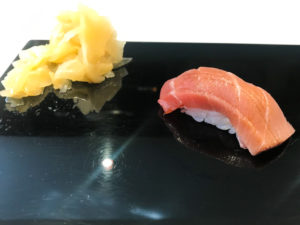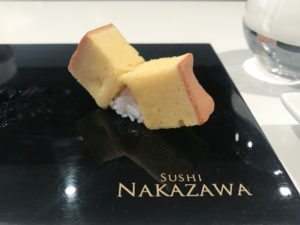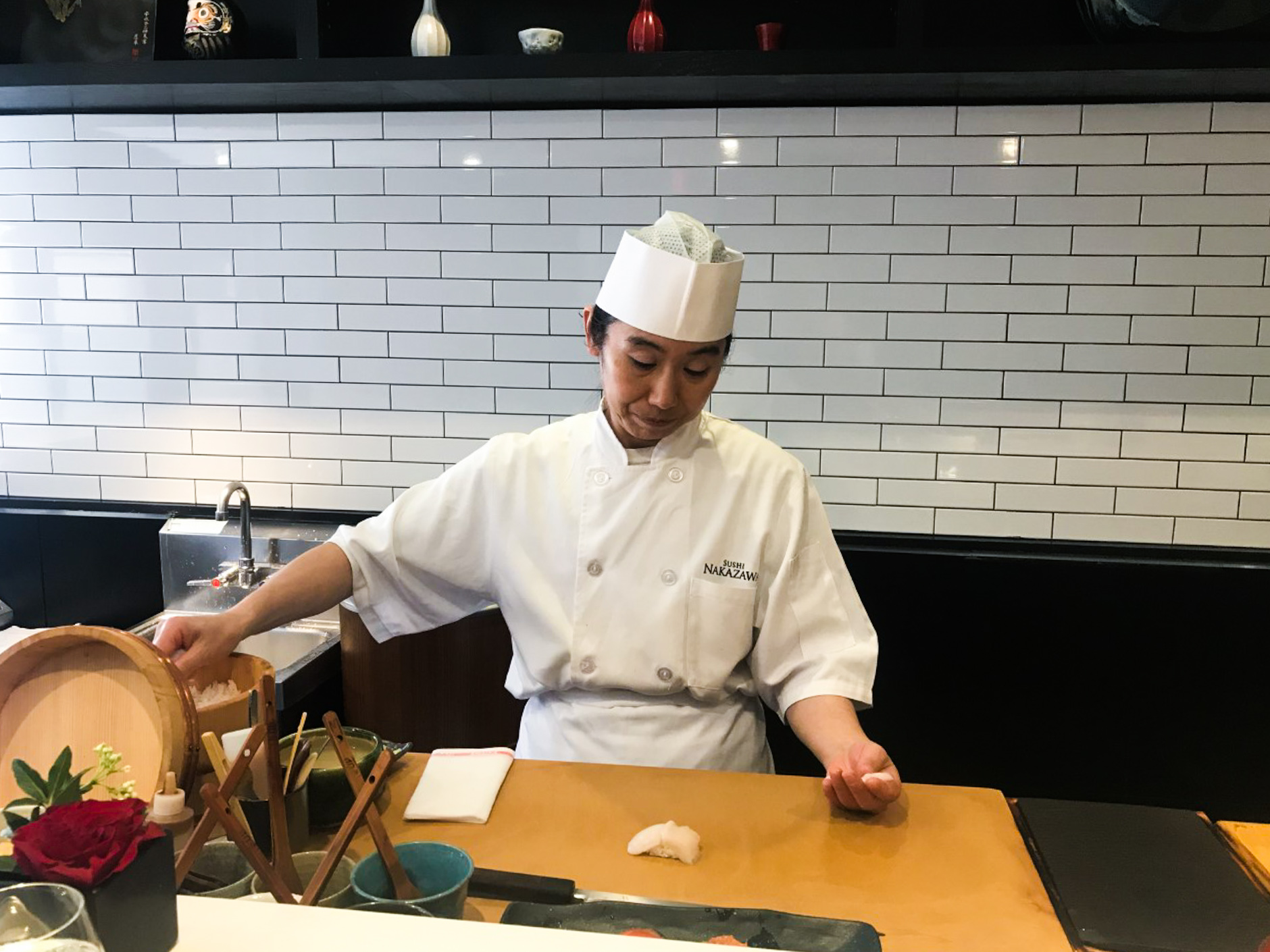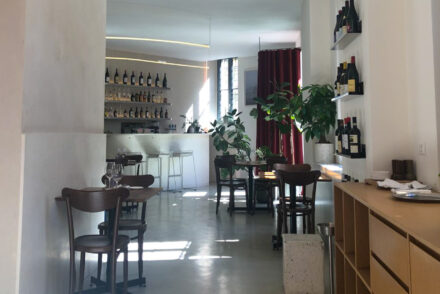I remember watching the documentary Jiro Dreams of Sushi on my friend’s Playstation Portable in the back of a classroom. We had to view it discreetly because it was pure pornography. It chronicled the story of Jiro Ono, a 91-year old savant obsessed with creating the best sushi in the world. Slow-motion shots of Jiro serving delicate pieces of sushi set to emotional classical music were arranged with scenes of his apprentices solemnly grilling seaweed in an empty corridor or massaging octopuses for half an hour. The film was a tremendous success, and his 10-seater restaurant in the basement of a Ginza office block now draws pilgrims from all around the world.
This is a sushi restaurant imbued with the heritage of Tokyo but yet can only really exist in New York
One of his featured disciples was a certain Nakazawa-san, who broke down in tears after detailing how he had to learn to make the Tamago egg custard dish over 200 times before being acknowledged by Jiro as a fellow craftsman. That scene made Nakazawa famous, and he moved to New York in 2014 to open his eponymous restaurant in Greenwich Village. There is no menu, only a $150 omakase where the menu is at the chef’s own discretion. The chefs are all Japanese, but some of the waiting staff are so local that they were genuinely shocked when I said “please” and “thank you”.

Bluefin tuna
The décor is deliberately shocking. New age furnishings, subway-tiled walls and black lacquered kitchen counter scream New York, as opposed to the minimalist wood-panelled sushi restaurants one finds literally everywhere else. The lighting is bright like a dentist’s, and the reflections of white lights on the monotonous furnishings a little too harsh. I’ve seen police stations with softer interior lighting than Sushi Nakazawa. And somehow, it all works. It feels like the chef is trying to make a statement, that he is not recreating Sukiyabashi Jiro in America, and he is ready to bring his own philosophy of sushi-making to the world.
But first, a brief digression about sushi. It is such a curious cuisine because the ¥100 railway station standing sushi bars and ¥30,000 3-michelin starred restaurants in Ginza basically serve the same thing; raw fish on rice. And yet, conveyor-belt sushi, with its machine-forged rice bricks and limp slices of artificially-coloured tuna could not be more different from the fine dining variant. These exclusive restaurants source seasonal fish from snobs in Tokyo’s Toyosu market who only deal with customers whom they deem worthy of their precious catch. Chefs who work at these restaurants always have a specific rice farm they swear by, claiming that only this particular rice grown in this obscure village is good enough for their craft. Even the wooden kitchen counters are intricately carved from 200-year old Cypress trees. Their attention to detail put top Parisian chefs to shame.
And what is the point of this obsession? Of the 20-odd pieces of fish in a typical meal, the average NYC hedge fund manager who frequents this sort of establishment could probably recognise three at best: salmon, fatty tuna and sea urchin. In an effort to impress his date about his vast knowledge of Japanese culture, the customer next to me decreed loudly and proudly “I don’t like to have avocado in my sushi.” I had to stifle a laugh, and the phrase “no shit, Sherlock” sprang immediately to mind. Anyone who really knows what they’re doing would not go to Noble Rot and begin a diatribe against boxed wine. Unfortunately, these are the kind of customers that sushi restaurants in the city have to grapple with.
The hand-dived sea scallop was still alive and twitching when it was served with a sake glaze and yuzu pepper. It was clean, sweet and comparable to some of the best scallops I’ve had
Uninformed customers leads to another problem: ridiculous supplementary courses. Despite having a fixed-price menu, the waiter interrupted us midway to offer an additional piece of caviar sushi for $40. Not too long after, a wagyu beef course was offered for $15. And as if that was not enough, he tried to tempt us into shaving black truffles onto our sea urchin. The audacity! Truffles on sea urchin is a sushi dish exclusive to the capitalist temple of the Big Apple, an outrageous waste of fine ingredients designed exclusively for professional Instagrammers. It is, without a doubt a publicity stunt, but restaurants that do it really should serve this dish with a side order of regret and shame.

Tamago
Luckily, when the meal actually began, it was a 21-course journey into Nakazawa’s mind. Our chef for the day was a very friendly lady, rare for Japanese chefs, who hailed from Osaka. Sensing I was interested, she kindly explained the reasoning behind each piece’s composition. Traditional bluefin tuna and sea eel sushi were served alongside interesting pieces such as striped beakfish and baby amberjack. One of the outstanding pieces was a hand-dived sea scallop that was still alive and twitching when it was served with a sake glaze and yuzu pepper. It was clean, sweet and comparable to some of the best scallops I’ve had at Faviken and Hedone. Even though the seasoning was still broadly Japanese, it wasn’t conventional. This adventurous approach to seasoning and garnishing expectedly produced some hits, such as a crab and crab liver sushi which my companion loved, and some misses, especially a squid piece with sour plum paste that was both astringent and acidic.
The savoury courses ended with the Tamago, which had a texture somewhere between custard and pound cake with light hints of shrimp paste and dashi. This was the dish that made Nakazawa famous and it did not disappoint. Just as we thought everything was over, we were served a lychee sorbet, which was rich and honeyed, reminiscent of a middle-aged Chateau d’Yquem. I made sure to thank all the staff on the way out, which made the American waiters really uncomfortable again. After the meal, the Japanese maître d’ emailed me the full menu, which was a very nice touch.
At only half the price of other top-end sushi restaurants in New York, Sushi Nakazawa is very good value. And it doesn’t just compete on cost, but it provides a unique experience for those of us already familiar with good Japanese food. It is a sushi restaurant imbued with the heritage of Tokyo but yet can only really exist in New York: a testament to the benefits of immigration and cultural exchange in this troubled world.
23 Commerce Street
New York
New York 10014
USA
by J Khou






